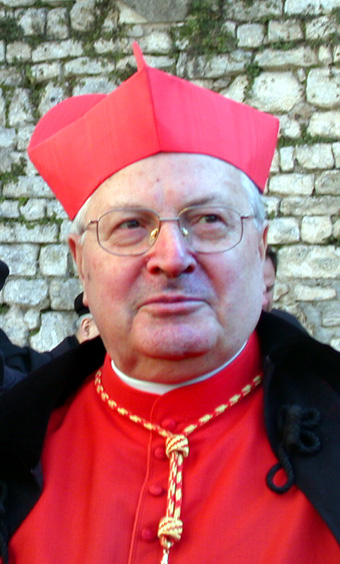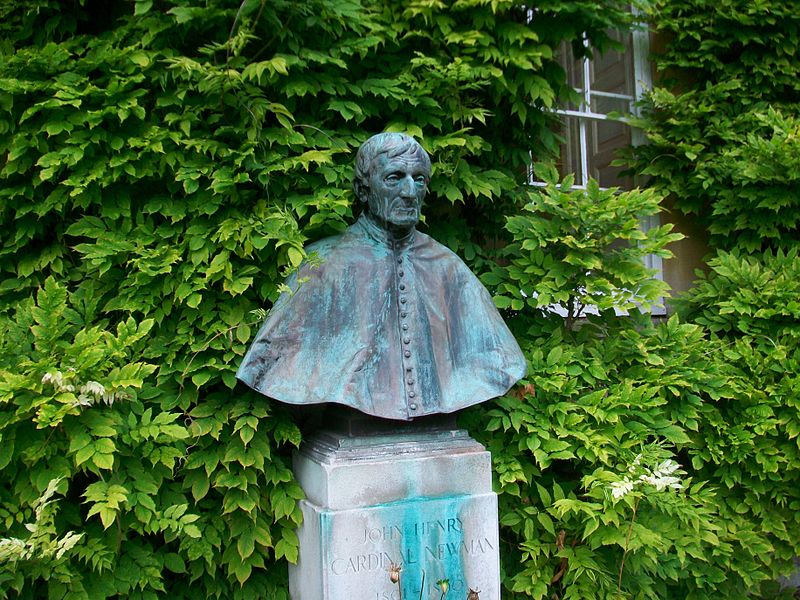The College of Cardinals is the body of all cardinals of the Catholic Church.
A function of the college is to advise the Pope about church matters when he summons them to an ordinary consistory. It also convenes on the death or resignation of a pope as a papal conclave to elect a successor. The college has no ruling power except during the sede vacante (papal vacancy) period, and even then its powers are extremely limited by the terms of the current law, which is laid down in the Apostolic constitution Universi Dominici Gregis and the Fundamental Law of Vatican City State.
Historically, cardinals were the clergy serving parishes of the city of Rome under its bishop, the Pope. The College acquired particular importance following the crowning of Henry IV as King of Germany and Holy Roman Emperor at the age of six, after the unexpected death of Henry III in 1056. Until then, secular authorities had significant influence over who was to be appointed Pope, and the Holy Roman Emperor in particular had the special power to appoint him. This was significant as the aims and views of the Holy Roman Emperor and the Church did not always coincide. Churchmen involved in what was to become known as the Gregorian Reform took advantage of the new king's lack of power, and in 1059 reserved the election of the Pope to the clergy of the Church in Rome. This was part of a larger power struggle, which became known as the Investiture Controversy, as the Church and the Emperor each attempted to gain more control over the appointment of bishops, and in doing so wield more influence in the lands and governments they were appointed to. Reserving to the cardinals the election of the Pope represented a significant shift in the balance of power in the Early Medieval world. From the beginning of the 12th century, the College of Cardinals started to meet as such, when the cardinal bishops, cardinal priests, and cardinal deacons ceased acting as separate groups.
The Dean of the College of Cardinals and the Sub-Dean are the president and vice-president of the college. Both are elected by and from the cardinals holding suburbicarian dioceses, but the election requires Papal confirmation. Except for presiding, the dean has no power of governance over the cardinals, instead acting as primus inter pares (first among equals).
The Secretary of State, the prefects of the Congregations of the Roman Curia, the Camerlengo of the Holy Roman Church, the Vicar General of Rome, and the Patriarchs of Venice and Lisbon, are usually Cardinals, with few, usually temporary, exceptions. The Fundamental Law of Vatican City State requires that appointees to the state's legislative body, the Pontifical Commission for Vatican City State, be cardinals.
Origins
The Church cites Acts 6 as the formation of the Sacred College of Cardinals. Specifically, the seven assistants, Stephen, Philip, Nicanor, Timon, Nicholas, Parmenas, and Prochorus, selected by the Apostles to relieve them of the more mundane tasks of the Church so that they might concentrate more on prayer, contemplation, and preaching. As early as the third century, these assistants were defined as critical supporters of the papacy, and by the fourth century, the title of Cardinal was applied to these consultors of the Pope.
The word cardinal itself is derived from the Latin "cardo", meaning "hinge". The cardinals were believed to facilitate a relationship between the theological and governmental roles of the hierarchy of the Church as a sort of pivot; on them hung the relationship between Christ and His Church on Earth, headed by the pope. This definition of helper has not changed over the years, and popes have not ceased to depend on the College for advice on doctrine and government.
Towards the end of the 600s, the title of Cardinal had become synonymous with an honor, and was no longer reserved to men who served the pope as special assistants. Sts. Augustine and Ambrose applied the term to truths of life and Christian virtues respectively. In 845 the Council of Meaux "required Bishops to establish Cardinal titles or parishes in their towns and outlining districts." At the same time, the popes began referring to the cardinal priests of Rome to serves as legates and delegates within Rome at ceremonies, synods, councils, etc., as well as abroad on diplomatic missions and councils. Those who were assigned to the latter roles were given the titles of Legatus a latere (Cardinal Legate) and Missus Specialis (Special Missions).
During the pontificate of Stephen V (816-17), the three classes of the College that are present today began to form. Stephen decreed that all cardinal-bishops were bound to say Mass on rotation at the high altar at St. Peter's Basilica, one per Sunday. The first class to form was that of the cardinal-deacons, direct theological descendants of the original seven ordained in Acts 6, followed by the cardinal-priests, and finally, the cardinal-bishops.
The College played an integral part in various reforms within the Church as well, as early as the pontificate of Pope Leo IX (1050). In 759, the third Lateran Council declared that only Cardinals could assume the papacy, a requirement that has since lapsed. In 1130, under Urban II, all the classes were permitted to take part in papal elections; up to this point, only cardinal-bishops had this role.
By the end of the 1300s, the practice of solely Italian cardinals had ceased. Between the 1300s and 1600s, there was much struggle for the College between the cardinals of the day and the reigning popes. The most effective way for a pope to increase his power was to increase the number of cardinals, promoting those who had nominated him. Those cardinals in power saw these actions as an attempt to weaken their influence. In 1517, Pope Leo X added another thirty-one cardinals, bringing the total to sixty-five so that he could have a supportive majority among the cardinalate. Paul IV brought the total to seventy. Pius IV raised an additional six. By the papacy of Sixtus V, the number was set at seventy, divided among fourteen cardinal-deacons, fifty cardinal-priests, and six cardinal-bishops.
Choosing the Pope

Under the terms of Pope Paul VI's motu proprio Ingravescentem Aetatem, cardinals who reached the age of 80 before a conclave opened had no vote in papal elections. Pope John Paul II's Universi Dominici Gregis of 22 February 1996 modified that slightly, so that cardinals who have reached the age of 80 before the day the see becomes vacant do not have a vote.
Although the canonical qualifications required of candidates for episcopacy leave a broad field open to the cardinals, they have for over six centuries elected one of their own number to be Bishop of Rome. The last time they chose someone who was not a cardinal was at the 1378 election of Pope Urban VI. The conclave rules specify the procedures to be followed, should someone residing outside Vatican City or not yet a bishop be elected.
Of the 117 Cardinals under the age of 80 at the time of Pope Benedict XVI's resignation, 115 participated in the conclave of March 2013 that elected his successor. The two who did not participate were Julius Riyadi Darmaatmadja (for health reasons) and Keith O'Brien (for personal reasons). Of the 115 Cardinals who participated in the conclave that elected Pope Francis, 48 were appointed by Pope John Paul II, and 67 by Pope Benedict XVI.
As of 14 February 2015, there are a total of 227 cardinals, of whom 125 are under age 80. Of those 125, 34 were appointed by Pope John Paul II, 60 by Pope Benedict XVI, and 31 by Pope Francis. Antonios Naguib will be the next cardinal to reach the age of 80, on 18 March 2015, and lose his right to participate in a conclave.
Members of the College of Cardinals

The following is the list of all cardinals living as of 14 February 2015. Cardinals appear in order of precedence, based on seniority by date of appointment. Paulo Evaristo Arns is the most senior member of the College by length of service (the Protopriest) and the last survivor from the 1973 consistory. Angelo Sodano has the highest precedence as a Cardinal Bishop and Dean of the College of Cardinals. As of 14 February 2015, the oldest living cardinal is Loris Francesco Capovilla, born in 1915.
Within the College of Cardinals, there are three categories, the highest-ranked Cardinal Bishops, then Cardinal Priests, and finally Cardinal Deacons. Within each category, cardinals are ranked by seniority of appointment to that category. Despite these titles, almost every cardinal is, since the pontificate of Pope John XXIII (1958â€"1963), a bishop. Any one not a bishop when his appointment is announced has generally been consecrated bishop before his formal installation, although a few priests appointed cardinals when near or over 80 have obtained permission not to become bishops.
Most of the cardinals are from the Latin Church; those who are from the Eastern Catholic Churches have their church indicated.
Cardinals from Italy over time (percentage)
Cardinals vs. geographic distribution of Catholics
Cardinals by nationality
Size of the College of Cardinals
As of 14 February 2015, the College had 227 members, 125 of whom were eligible to participate in a conclave. The group's size has historically been limited by popes, ecumenical councils, and even the College itself. From 1099 to 1986, the total number of cardinals appointed was approximately 2900 (excluding possible undocumented 12th-century cardinals, cardinals appointed during the Western Schism by pontiffs now considered to be antipopes, and subject to some other sources of uncertainty), nearly half of whom were created after 1655.
See also
Notes
External links
- The College of Cardinals â€" Holy See Press Office
- GCatholic.org â€" extensive information on all cardinals since the 17th century
- Cardinals of the Catholic Church â€" sortable list, often slightly out of date on deaths
- Catholic-Hierarchy.org, with entry into extensive databases.







0 komentar :
Posting Komentar